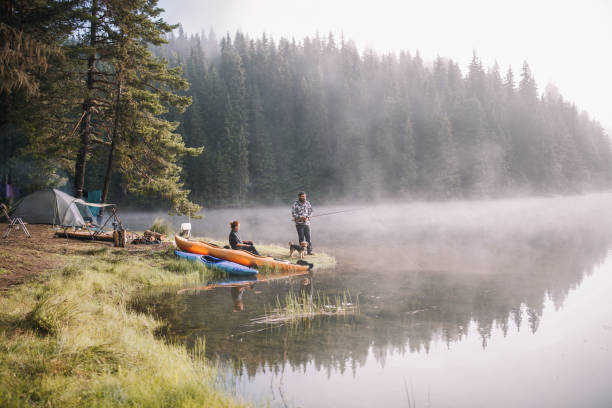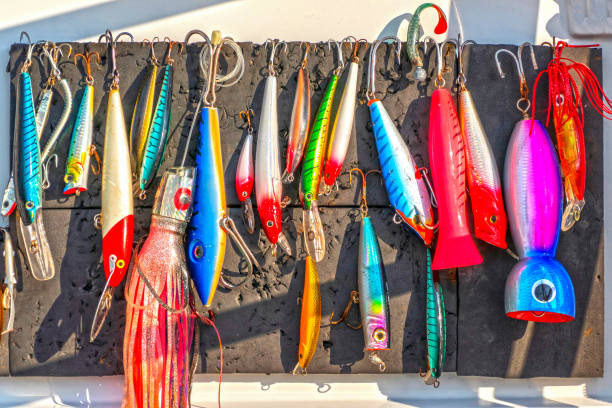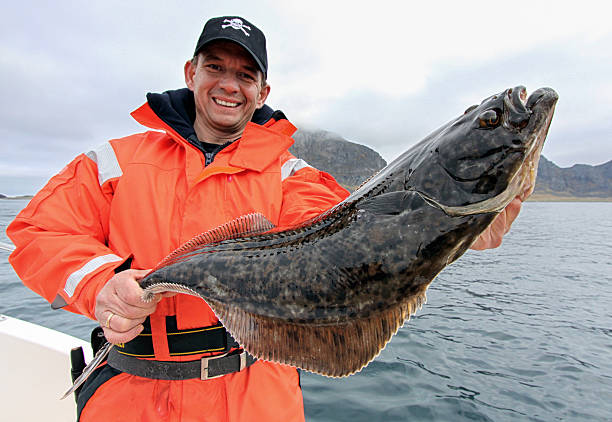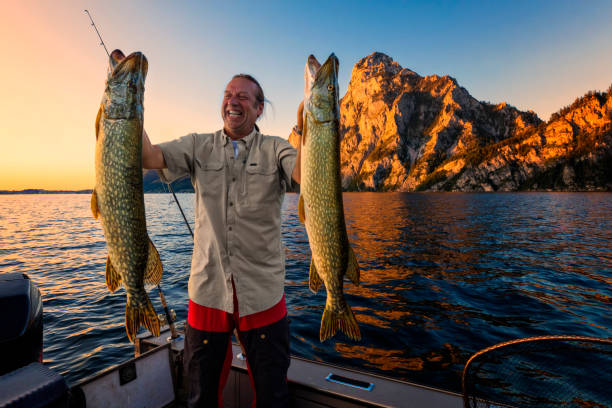Fishing can be a challenging activity and possessing high-quality fishing rods can surely assist with this. Regardless of whether anglers are in pursuit of elusive trout, bass, or other types of fish, a good fishing rod is always advantageous. In the present day, there’s an array of rod variants crafted from diverse materials. The weight and balance of the rod contribute to the perfect feel required for a full day’s fishing seeking the perfect catch.
You may also like:
Best Fishing Reels
Best Fishing Waders
Magnet for Magnet Fishing
Best Spinning Reels
How to Choose the Best Fishing Rod
Anyone who’s new to fishing doesn’t need to worry about the gear from the start. The right gear might seem a long way ahead at this moment. But those who like fishing need to know all of the current fishing rods with their materials are primarily made for the cast.
The biggest difference in fishing rods is in casting. A telescoping rod casts differently from a fly fishing rod. But they’re not going to stop a good fisherman from catching fish in any condition. The length of the rod is going to impact casting distance. Simply put, the longer a rod is, the longer it can cast. But there are limits in physics and at some point, fishing rods simply become too heavy.
The Place Where You Want to Fish
Rod lengths might not be as important in certain scenarios such as fishing boats. It might just be one of the key elements to assess. Fishing on mountain streams doesn’t require too much casting strength. The same applies to ocean fishing. Anyone out with kids knows casting strength is still not there for the little ones. A short fishing rod is the best for them.
Depending on the fishing locations, users also need to establish the type of fishing rod which is going to support the best casting. For this to happen, the distance of the casting needs to be established. Ponds are usually where fishing is done from the banks. These types of locations normally require a long rod for a long cast.
But then there are other types of locations. Heading upstream to mountain fishing locations normally requires a shorter rod. Anywhere between 6 and 8 feet is going to prove particularly good. Choosing a longer fishing rod here is only going to make the life of the user more difficult. Casting distance is considerably reduced here.
When it comes to kayak fishing, the length of the rod is given by storage limitations. This is why it should always be a rod that can fit inside the kayak. Otherwise, there are accessories that also allow fishing rods to be stored on top of the kayak for those who want to still use long designs.
In ice fishing, the length of the rod is going to be troublesome as well. There’s no considerable casting distance to worry about and as a result, it’s going to only require a short fishing rod.
Fishing off a boat is often imagined with long rods. This is also not the case. There’s no point in baitcasting the rods too far out when larger fish can be anywhere out in the ocean. Here are the types of rods to consider according to the fishing location described in detail.
Rod Action
Rod action often features unknown to new fishermen. Printed directly on the rod, it refers to the stiffness levels of a certain design, A fishing rod can come with fast action and slow action rods. Fast action rods are stiffer and they’re recommended for extra casting power. Soft action rods are softer. They’re not usually used to cast as far as possible.
Rod bending is also important here. Each rod has different engineering. Some bend more towards the tip while others bend more towards the reel or the grip. Physics plays an important role here. Softer rods that bend more towards the grip are considered fun. They can offer an incredible feel while fighting the fish. But it also lacks the structure to cast heavy leads.
The rod action is also important for the lure. The heavy lure is going to require a heavier power rod. There’s no point in trying casting a heavy lure with a soft rod. This is why a lighter line is going to work best with a lighter power rod. It absorbs the shocks and the weight of the heavy lure and possibly heavy catch a bit better. When it comes to rod action, castability, fish fighting, and length all work together.
Since casting is crucial it separates various types of fishing rods. A medium bend is going to prove a good choice for anyone just starting out. Before embarking on a fishing journey, these rods offer a bit more support for the average lure and for the new fishing fans.
The same principles apply when considering the type of fish and the type of fighting to be expected from certain species. A medium-bend rod is going to prove particularly interesting for the average fishing needs. It allows users to keep the fish pinned better than a fast rod.
As seen above, the length of the rod is crucial. But it also has a lot to do with the action of the rod. Longwater cast is going to prove the perfect type of long rods. But not everybody is fishing from the shore. For example, anyone into kayak fishing knows a short fishing rod is a right way to go. They can be easier to handle and they’re also easy to store inside the kayak.
A new user is not going to be very comfortable with handling any fishing rod, particularly a long one. As a result, it’s central to use a short fishing rod which makes casting, skipping, and pitching a bit easier as well.
You may also like: Best Fishing Poles and Whips – 2021 Reviews
Rod Materials
Fiberglass and carbon fiber fishing rods are very popular today. They represent solid materials that can handle the needs of a beginner without any issue. But they are different and categorizing them as follows is the easiest method of differentiating them.
Fiberglass is the cheapest material. There are full and hollow fiberglass rods to choose from. All of them behave differently. But their diameter is also important in establishing their physics. Hollow fiberglass roads are going to be wider in diameter but not as resistant to tension as there’s no backbone to them. Narrow diameter fiberglass rods are normally extra-durable as there’s plenty of support to keep them under control.
E-glass and S-glass composite fishing rods are even better. Their hybrid materials are lighter and as a result, they are stronger and better for a wide range of fish. As expected, these fishing rods are mainly used for big fish. They support high force and stress on the fishing rod a bit better than carbon fiber alternatives as fishing gear as Shakespeare Ugly Stik GX2, Okuma Celilo, Abu Garcia, Ugly Stik Elite, Croix or Fuji rods.
Carbon fiber rods are very popular today. They offer a good balance between weight and flexibility. But most of the time, they’re in direct competition with fiberglass rods. Those on a budget can freely choose a good fiberglass rod. But those who can spend a bit more can get their hands on a good carbon fiber fishing rod as a step up.
Spinning Rods
Spinning rods are made to hold a spin baitcasting reel. They’re made with aluminum oxide guides facing down which means they’re highly suitable for fast water. Bass Pro is one of the leading brands in spinning rod manufacturing.
Spinning rods are also very good for those just starting out fishing. Since the line drops out immediately after the last loop, it becomes easier to reel. The line is free from tangles when it’s easier to reel. These types of rods prove practical and they also help develop key skills for new fishermen.
Casting Rods
Casting rods are mainly seen on open water such as in saltwater fishing. Anyone who’s seen shows with deadly catches knows these are the types of rods made for serious business. Their stainless steel guides are facing upwards. This means that the entire force from the battling fish is transmitted directly to the rod and not the eyelets such as with spinning rods.
Casting rods are very durable. However, they’re not the best for anyone looking to start out in the fish world. It takes some practice to master these rods and it’s best to first start with a rod that has eyelets facing down.
Telescopic Rods
Telescoping rods are among the best for beginners. They compact down and they’re easy to carry. These rods are made from various elements and they each collapse into the following larger element to a very compact size.
But even these simple rods come in different materials. Today, you can find them in materials such as carbon at very good prices. Furthermore, they are lightweight rods and versatile with the fishing reel. Anyone can start using these rods for any type of fishing.
Some of the best deals of the moment can be found on telescopic rods. They are usually the first to go on sale during the offseason. Anyone looking for the best deal is going to find telescoping rods at major retailers at a discounted price when the fishing season is over.
But this doesn’t mean telescopic rods aren’t good. It simply means they are made with more affordable materials that support an affordable final price. Anyone on a budge who would still like to get into fishing can easily do so with a telescoping rod.
At the same time, an inexpensive telescopic rod can also be used as a viable backup rod as well. It offers a cheap alternative to expensive rods as it can even come in a long length at a low price. Since it compacts to a small size, it’s also very easy to carry in the bag together with other fishing gear.
Pend Rods
Pend rods are even more compact than telescopic rods. They are often believed to be the smallest rods in the world and many use them to get around freely. Since they’re so small, they can be the right option for anyone traveling frequently. They easily fit a backpack and they are made with durable materials.
Pend rods are often interpreted as weak. But as seen with the materials above, they’re not made with hollow segments and they have a good backbone. As a result, pend rods can be used for all types of fishing including fast rivers and pond fishing.
Trolling Rods
Often seen on shows where fisherman goes for the largest fish, these rods do just what their name suggests. Used at the back of a boat to carry bait, they are considered for large fish. These rods are normally very durable.
Made for a large catch, the trolling rods are also often paired with strong lines and a robust fishing reel. These are not the right fishing roads to start the journey. Those new to the fishing world who still want to try them can rent out trolling rods or simply share them with boat fishing friends to see how they feel as they require a more considerable investment.
Sea Fishing Rods
Made with heavy tips, sea fishing rods also differ in length and materials. Short fishing rods are normally seen on boats or kayaks. They can be similar to trolling rods in design. But sea fishing rods can also belong. Anyone who’s been fishing while standing on rocks knows the importance of the length of the rod. But at the same time, these fishing rods are normally only made for sea fishing and they have little versatility on fast rivers.
Surf Rods
Similar to sea fishing rods, surf rods are long to make casting easier. But unlike sea fishing rods, surf rods are even longer. They are still found in most specialized shops today but they need to be accompanied by proper carry bags. Surf fishing rods need better protection as they can prove the most difficult to transport with their long elements.
Fly Fishing Rods
Fly fishing is a bit different than other types of fishing. It’s very active given it requires constant movement and deliberate casting of the fly multiple time and using both hands. If mastered, fly fishing can be very fun. Here’s what to look for when choosing a fly fishing rod.
The length of the rod is obviously important. As seen with a couple of the examples above, even the same rod comes in different lengths. In general terms, a length anywhere between 6 and 8 feet is considered versatile in fly fishing.
This is the type of length chosen when fly fishing on multiple rivers in various upstream and downstream locations. Anyone who hasn’t fished before and who’s starting out with fly fishing is finding these interesting.
Those fly fishing on still water is going to need a bit more casting power. This can be up towards the 9 feet point. With such a long fly fishing rod, casting becomes easier. But even on some wider rivers, this fishing rod can be useful.
However, there’s a disadvantage given by its length and its extra weight. As mentioned before, fly fishing is very active and it can become tiresome to simply fly fish with such a long rod all day. Anyone buying such rods needs to expect tired hands a bit faster than with an 8ft alternative.
Rod weight is also important and it’s numbered and printed on all fishing rods. For most trout fishing needs, any design between weight 1 and weight 8 is going to do the job well. For bass fishing, a rod with a weight 6 to weight 10 is going to prove a bit better.
Which fly fishing road to choose between a 2-piece, 3-piece, or 4-piece? The way in which fly fishing rods are constructed is different from telescoping rods. They’re taken apart as they’re made from pieces that are then stored next to each other and which don’t collapse. This means that a 2-piece needs a bit less preparation before going fishing than a 4-piece.
But there are exceptions and all of them apply to travel fishermen. For example, a 4-piece might actually be shorter in size for traveling purposes when inside a fishing bag. A 2-piece is going to prove a bit longer and harder to transport. But anyone seriously considering the benefits of a 4-piece also knows its physics is a bit different and it might be a better option when going for the larger catch.
Ice Fishing Rods
Ice fishing rods are normally very short. The longest ice fishing rod is not just 36 inches which makes it perfect for fishing on the ice. Drilling a hole in the ice and then staying all the way back is not the way to ice fish. Ice fishing rods are very short and they offer an immediate feel whenever fish strikes. They aren’t as versatile for the large catch or for any other type of fishing. However, other types of fishing rods can’t be used in ice fishing as well.
Setting Up a New Fishing Rod
Once the purchase has been made, it’s now time to set up the fishing rod. The examples above already come with fishing rods and other accessories and they are quick to put together.
Putting the Fishing Rod Together
The 2 to 4 pieces of the fishing rod need to be put together. Telescoping rods need to be pulled out to the degree where they don’t collapse on their own when the rod stays vertically.
But as seen with most fishing rods above, the pieces need to be put together so that the eyelets align. Most of the time, the eyelets align below the rod itself. Once they are properly aligned and the pieces properly inserted into another, it’s time to put the fishing line on.
Put the Line on the Reel
The line is the most important when it comes to maintaining rod durability. It usually breaks before the rod is chosen correctly. This is where the best fishing rod needs to be paired with the best fishing line.
Up to 300 yards of a line can be seen on a fishing reel at a time in general. To put the line on the fishing reel, users first need to ensure the rod is properly set up. When the line is close to the fishing rod cap, it can simply be tightened down. Any excess line needs to be cut from the lockdown for proper wind. It’s now time to wind the line onto the fishing reel.
Frequently Asked Questions
How to transport fishing rods in the car?
Transporting fishing rods depends on their length. They’re mostly transported in the trunk. Those who have a roof rack might have an alternative. But for the average fisherman, having a carry bag is crucial. The bundles above are easier to transport with their included carry bags and also protect during transportation.
Is an expensive fishing rod worth it?
For the average user, investing in expensive fishing rods is not a must. Among the simplest designs to consider, there are even a few carbon fiber rods that can be purchased at a low price. But for many users, there’s little point in looking for the ultimate materials with the first purchase.
What many fishing gear salespeople fail to inform the new user is the concomitant purchases made once fishing skills and experience improve. Many new fishermen simply don’t realize how much their fishing perspective improves in time. As with cameras, the best fishing rod is the one in the hands.
What is more important, rod or reel?
Both the rod and the reel are important and they can limit their performance to each other. The best rod needs the best fishing reel. Most of the products above come with their own fishing rods but they can also be used with secondary rods if purchased separately.
Some fishing rods come with no fishing reels which need to be purchased separately. Fishing reels can be mounted on all rods but they are different. Fly fishing reels are different from regular spinning reels. Both can be purchased at various prices and they’re both made to hold different types of lines. A few good fishing reel brands include Shimano, Daiwa, and Okuma.
The line in fly fishing is thicker and as a result, the reel can only hold the shorter line. But in regular fishing, the line is considerably thinner. As a result, the spinning reel can hold around 100m or more than 300 feet of line. Both of these have their place in fishing, especially in casting.
Also read: Guide to the Best Baitcaster Reels in 2021
Do graphite rods break easily?
Graphite rods are now very popular. More affordable than before, graphite fishing rods are very easy to use. They are as easy to use as the simple fiberglass rods but they’re often associated with easy breaks, which is certainly not the case.
The easiest method to ensure the graphite shaft won’t break is to look for a line that has a lower weight capacity than the rod itself. This means the rod is the first to give in case of a heavy catch.
It takes the impact and in case it brakes, it doesn’t come with considerable financial losses as would be the case with a broken fishing rod. Most modern graphite rods come with stainless steel accessories such as eyelets for extra durability.
What is the difference between fly fishing and regular fishing?
Fly fishing requires using natural or artificial flies as bait. But it’s the style of fishing that differentiates itself from regular fishing. Those who want to try out fly fishing are going to need to master the perfect cats with weighted lines.
With a more active style of fishing, it is also considerably more engaging than other types of fishing. Even when fly fishing on ponds flies fishing is still more active than regular fishing.
Specialized fly fishing gear includes sets of flyes as seen in the examples above. Together with a specialized floating line, it allows fishermen to easily keep an eye on the line and always know where it lies on the water.





